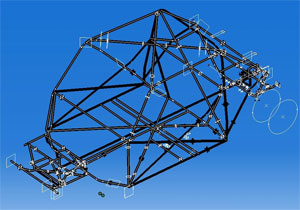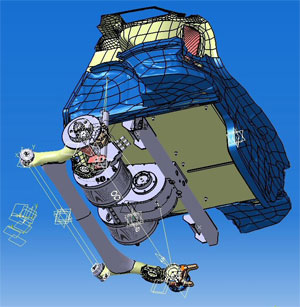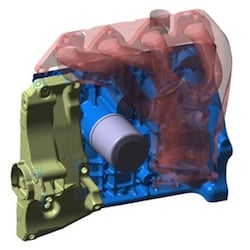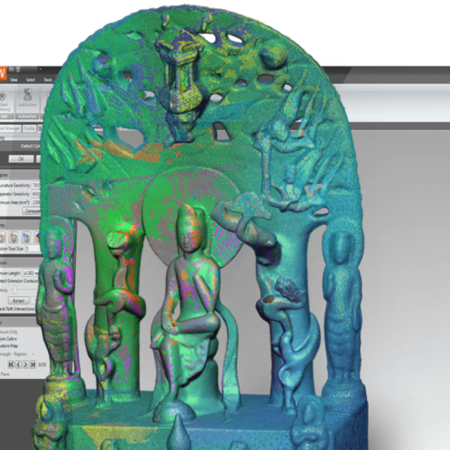The use of Geomagic Wrap 3D reverse engineering software at leading automotive design, development and certification organization, MIRA, enables the rapid creation of 3D digital models for use in downstream vehicle design and engineering tasks.
When your client wants you to develop a special-purpose vehicle based on a standard production vehicle, chances are that you won’t have access to any of the original design information relating to that vehicle. In particular, the original CAD data will not be available. So you either have to generate the data yourself or revert to using traditional manual design methods.

In the past, when automotive design and engineering specialist MIRA was faced with this situation - a fairly common occurrence for the company – this was the choice it faced. However, since the company made the decision to take advantage of the latest in 3D scanning technology, together with scan data processing and reverse engineering software in the form of Geomagic Wrap, it was no longer a problem for them.
Due to the nature of much of the work that MIRA undertakes for its clients in the automotive industry, original design data is often not available to it. With a history that goes back to the founding of the Institute of Automobile Engineers in 1898, MIRA provides product engineering, research, testing, information and certification services to the worldwide automotive industry.
(Image 1: The components of this vehicle rollcage were digitally captured by MIRA using Geomagic Wrap and then exported to CATIA where they were assembled.)
With twelve offices in ten countries, the depth and breadth of the services the company offers its clients range from one-off projects, such as performance testing an existing vehicle component or assembly, to turn-key projects that start from a blank sheet and involve the design, development, engineering and prototyping of a complete vehicle. It might also include the design of the production line and facilities required for manufacturing the final vehicle.
From physical to digital.
It’s within MIRA’s Product Engineering division at the company’s headquarters near Nuneaton, in the UK’s industrial heartland, that 3D scanning and reverse engineering now forms an integral part of the overall automotive design and engineering process. The company had used touch probe coordinate measuring machines (CMMs) to collect discrete point measurements for some years but these aren’t suitable for the digital capture of complex geometric shapes or of products made from deformable materials, such as plastics.
So the decision was made to evolve to the use of the latest non-contact scanning and 3D scan data processing technology in the form of a FARO Laser ScanArm optical scanner and Geomagic Wrap 3D reverse engineering software. This enables the digital capture of physical objects and the subsequent automatic creation of accurate 3D digital models of them, with associated structural properties, for use in downstream design, engineering, inspection and custom manufacturing processes.
The two main uses for the technology at MIRA are benchmarking projects and design-led activities. Benchmarking projects often involve testing vehicle components and assemblies for compliance with pedestrian and passenger safety regulations. Design-led activities might involve developing a special-purpose vehicle from an existing production vehicle or producing Class A surfaces from styling models.
“The big benefit to us of 3D reverse engineering is that when there is no original design information available for us to work with, we are able to rapidly create our own accurate 3D digital model of the component or vehicle that will form the basis of our new design,” explains Dave Wykes, senior engineer, Vehicle and Systems Engineering Group at MIRA. “This gives us the information we need to take on into the design and/or analysis process and enables us to have confidence in the feasibility of our downstream design and engineering activities,” he adds.
The essential digital model.
Much of the new design work, engineering analysis and benchmark testing that MIRA undertakes for its clients can only be performed effectively with the use of a 3D digital model. So whether it’s the testing and measurement of components under load, understanding the performance of a competitive product or creating a datum for new design work, the starting point is to perform a digital scan of the part or assembly in question.
The FARO Laser ScanArm 3D digitizer fully integrates a contact/non-contact measurement device and laser scanner and can capture more than 19,000 points per second. The data is saved as a point cloud which represents, within an accuracy of 50 microns, the set of three-dimensional points that describes the outlines of the object being digitized. Once captured, the point cloud is brought into Geomagic Wrap software for processing.

Geomagic Wrap is the critical component in the digital model creation process. It extracts geometry and topology from measurement data and creates high-quality 3D digital models that can be used within other CAD, CAE and CAM applications for downstream functions such as detailed design, engineering analysis, simulation and rapid manufacturing.
Depending on the size of the point cloud, the first step in the process of creating a 3D digital model may be to reduce the data to a more manageable amount, without affecting its accuracy, by using random, uniform and curvature-based point sampling. It may also be necessary to eliminate ‘noise’ generated during the scanning process. Once this has been done, the next step is to create a polygon model from the point cloud data. In most cases, this is achieved automatically by using the Wrap feature in Geomagic Wrap. This mathematically wraps a polygon surface around the point cloud data with a few simple button presses.
(Image 2: Geomagic Wrap was used by MIRA to capture, manipulate and create a digital surface model which was then used as a base model in CATIA for the design of this hybrid drive.)
Tools within Geomagic Wrap then allow MIRA’s engineers to refine the polygon model, by filling any holes that might have been left by the scanning process and by smoothing, fitting, trimming, projecting and extending boundary edges, where necessary, to polish the model. The result is an accurate, ‘water-tight’ digital polygon model of the original physical object.
If the model is required for a design-led project, then Geomagic Wrap is used to convert the polygon model into a high-quality NURBS (non-uniform rational b-spline) surface model, which is then imported into the CATIA V5 CAD/CAM software suite used by MIRA for its detailed design engineering work. Geomagic’s Parametric Exchange technology enables 3D model data to be exported from Geomagic Wrap as parametric models in the native format of the receiving CAD system. Once in the CAD system the model can be edited immediately, as required, to create a new or revised product for incorporation into the digital ‘master’ product model.
However, if the model is required for a benchmarking or engineering analysis exercise, then the polygon model is saved as an STL file in Geomagic Wrap for export to a CAE application, such as finite element analysis (FEA) or computational fluid dynamics (CFD) analysis.
Interaction with CAD.
In design-led projects, the use of Geomagic Wrap software and CATIA CAD software in tandem with each other enables MIRA’s engineers to take a project seamlessly from initial surface model creation, through design modification, engineering analysis, documentation and through into prototype production.
A good example of this can be found in some of the work the company carries out for the motor-sport industry. World Rally Car and European Touring Car Championship cars, for example, are based on standard passenger cars. An essential component of these highly modified and extremely fast cars is the roll cage which ensures driver safety. This is usually a bespoke design and must meet international standards to ensure that it will adequately protect the driver – and the navigator in the case of rallying – in the event of a high-speed crash or roll-over.
The traditional way of testing a new roll cage design is to put it through a physical crash test – and in the process, of course, destroy it. Unfortunately, more often than not this will be the only one in existence. This fact, coupled with the increasing use of exotic materials such as high-strength steels in roll cages, means it becomes an expensive and time-consuming exercise.
Now MIRA’s engineers are able to create an accurate 3D digital model of the roll cage, using Geomagic Wrap. This model can then be exported to CATIA for the design development process or to various CAE software products for use in engineering analysis. Using this process, MIRA is currently the only organization in the UK that is able to certify bespoke roll cage designs to international standards – without the need to crash test and destroy expensive physical prototypes.
The company also uses a similar approach to the design of new vehicles, such as hybrid, emergency and mobility vehicles that are based on existing production vehicles. Usually there is no original CAD data available. So Geomagic Wrap is used to create 3D digital models of the appropriate parts of the donor vehicle. These models are then used within CATIA to enable the required changes to be made. These might involve changes to the power-train and chassis in order to accommodate a hybrid power unit or in the case of a mobility vehicle, changes to the suspension and bodywork to provide wheelchair access.
Confidence in the results

Apart from giving MIRA the ability to design and engineer automotive parts as well as complete vehicles in less time and with greater accuracy and confidence in the end result, the combination of 3D scanning and reverse engineering, CAD and CAE enables them to avoid the tendency to ‘over engineer’ a product, as often happens in the traditional manual world in order to ensure it won’t fail. With a digital model everything can be digitally simulated and tested, saving tremendously on time and cost.
“There’s no doubt that the use of Geomagic Wrap has enabled us to offer services that we couldn’t offer before,” says Wykes. “More than that though,” he adds, “perhaps the biggest benefit internally is that with a 3D digital model, management can see what is being done and can have confidence in the process, as well as in the end result.”
And when it’s often people’s lives that depend on much of the work that MIRA undertakes for its automotive industry customers, that’s an important benefit.
(Image 3. An engine designed by MIRA in CATIA using digital surface model data created with Geomagic Wrap software.)
